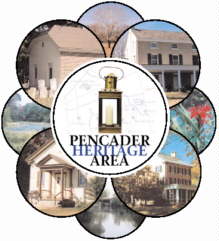 One of Pencader Hundred's historic homes is located approximately three-quarters of a mile west of Cooch's Bridge on the South side of the road at a slight curve of Old Baltimore Pike. This stone and frame dwelling has presented researchers with almost as many questions as answers concerning its past. A map by Henry Heald dated 1820 shows the owners name as Stewart with the symbol for a tavern after his name. Several tavern licenses also exist: one for John Ellison in 1803 for the Iron Hill Tavern, formerly the Black Horse, and another in 1808 for Justis Wilson, again for the Iron Hill Tavern. Tavern keepers Abraham Warrick, William Stewart, James Kinkead, James Livingston as lived in the house.
One of Pencader Hundred's historic homes is located approximately three-quarters of a mile west of Cooch's Bridge on the South side of the road at a slight curve of Old Baltimore Pike. This stone and frame dwelling has presented researchers with almost as many questions as answers concerning its past. A map by Henry Heald dated 1820 shows the owners name as Stewart with the symbol for a tavern after his name. Several tavern licenses also exist: one for John Ellison in 1803 for the Iron Hill Tavern, formerly the Black Horse, and another in 1808 for Justis Wilson, again for the Iron Hill Tavern. Tavern keepers Abraham Warrick, William Stewart, James Kinkead, James Livingston as lived in the house.
The tavern symbol corresponds to the description in Francis A. Cooch's book, History of Newark, Delaware and Its Environ's, of a farm and dwelling at the same location purchased by John Soreth in 1878:
When John Soreth purchased this farm nearly fifty-eight years ago he must have had a stout heart. The dwelling, once a hotel, known as the Half Way House, was the only building on the farm. It must have been an old house then. The east end is of logs and the west of native stone, whose huge corners puzzle one to think how the builders raised them into place. No doubt, the log end is the older, its chimney breast is over thirty inches deep, and this unit may well be over two hundred years old, but both units are so soundly constructed that, barring the accident of fire, they may last another two hundred years to come.
Unfortunately, the log section deteriorated and was removed by twentieth century owners who photographed the demolition
leaving us some proof of its existence. This bit of documentation is important as it helps define the house as one possibly owned by
Benjamin Henry Latrobe, (1764-1820) one of America's most famous civil engineers and architects.
Latrobe purchased a farm on the top of Iron Hill at the end of January, 1804, in order to move his family closer to his work on the
feeder canal that was to supply water to a proposed Delaware and Chesapeake Canal. He also praised the healthy, cool summer air
on the hill which was in direct contrast to the hot, sultry atmosphere in Wilmington and Philadelphia, air which gave rise to the
dreaded mosquito borne, yellow fever epidemics that would later claim both Benjamin Latrobe's life and that of his son.
Latrobe described the farm in a letter to his father-in-law as having a two-story log house on the premises, one that he later
enlarged for his growing family. As stated in his journals, his favorite building material was stone. Local stone was available
in great quantities on Iron Hill and the west end of the house in question is made of the distinctive iron-rich stone of the area. The
letters also mention the convenience of having the Turnpike pass by the front door.
The difficulty in tracing the deeds directly back to the Latrobe purchase arises from a defect in the title, caused by the owner, who
was a ship's carpenter, running away to sea. His wife was forced to petition the courts to clear the title enabling her to sell the
property and the resulting documents, which would prove the house belonged to Latrobe, have yet to be found. However, the
search continues.
|
